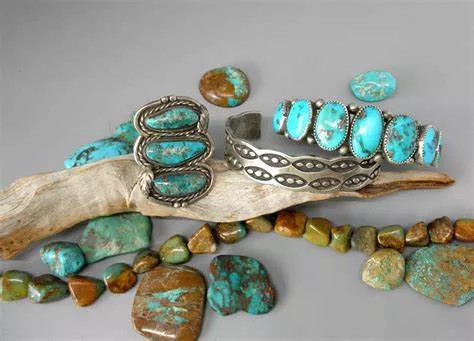Turquoise is a stunning gemstone known for its vibrant blue and green hues. Many people wonder about the cost of turquoise per carat. However, turquoise pricing is not as straightforward as diamonds or other gemstones. Unlike most gems, turquoise is often sold by size, quality, and origin rather than strictly by carat weight.
In this guide, we will explore the factors that influence turquoise pricing, how turquoise is valued, and what you should consider when buying this beautiful gemstone.
Why Turquoise Isn’t Always Priced by the Carat
Most gemstones, like diamonds, rubies, and sapphires, are priced per carat. However, turquoise is different. Here’s why:
Density Variations: Turquoise is a porous stone, meaning its weight can vary even if two pieces are the same size.
Cut and Shape: Turquoise is often cut into cabochons (smooth, rounded shapes) rather than faceted stones, so carat weight is less important than dimensions.
Matrix and Texture: Some turquoise contains veins of other minerals (called matrix), which can affect its appearance and value more than its weight.
Instead of pricing by carat, turquoise is usually sold based on:
- Size (in millimeters or inches)
- Quality (color, hardness, and finish)
- Origin (where it was mined)
- Treatment (whether it has been stabilized or enhanced)
- Now, let’s explore these factors in detail.
Key Factors That Determine Turquoise Value
Color: The Most Important Factor
Turquoise comes in many shades, from sky blue to deep green. The most valuable colors are:
Robin’s Egg Blue: A pure, bright blue without green tones.
Persian Blue: A rich, medium blue, traditionally from Iran.
Spiderweb Turquoise: Blue or green with dark matrix veins in a web-like pattern.
Lower-value colorsinclude:
Greenish Turquoise: More common and less expensive.
Yellowish or Dull Turquoise: Less desirable and often cheaper.
Hardness and Durability
High-quality turquoise is naturally hard and doesn’t need treatment. Softer turquoise is often stabilized (reinforced with resin) to make it durable enough for jewelry.
Natural, Untreated Turquoise: The rarest and most expensive.
Stabilized Turquoise: More affordable but still beautiful.
Reconstituted Turquoise: Made from small turquoise pieces bonded together—least valuable.
Origin:Where the Turquoise Was Mined
Some turquoise sources are legendary for their quality:
Persian (Iranian) Turquoise: The finest and most expensive.
Sleeping Beauty (Arizona): Bright, pure blue with no matrix.
Nevada Turquoise (Lander Blue, Number 8): Highly collectible.
Chinese Turquoise: Often dyed or treated, making it more affordable.
Matrix:The Veining in the Stone
Matrix refers to the dark veins running through turquoise. Some buyers love it, while others prefer clean stones.
Spiderweb Turquoise: Delicate, web-like matrix—highly prized.
Bold Matrix: Thicker veins, which can lower value if too dominant.
No Matrix: Pure, uniform color—very rare and expensive.
Cut and Shape
Turquoise is usually cut into cabochons for rings and pendants. Some popular shapes:
Oval: Classic and versatile.
Round: Less common but elegant.
Freeform: Natural, organic shapes—popular in Native American jewelry.
The craftsmanship of the cut affects price. A well-polished, symmetrical cabochon is worth more than a rough-cut stone.
Jewelry Setting and Brand Influence
A turquoise stone set in sterling silver will cost less than one set in gold. Designer brands (like Tiffany & Co.) also increase the price significantly.
How Turquoise Is Priced in the Market
Since turquoise isn’t strictly sold by carat, here’s how pricing works:
High-End Turquoise (Top Quality, Rare Origins)
Persian and Sleeping Beauty turquoise can be very expensive, especially in larger sizes.
Collector-grade spiderweb turquoise from Nevada also commands premium prices.
Mid-Range Turquoise (Stabilized, Good Color)
Most commercial turquoise falls here.
Stabilized stones are more affordable but still beautiful.
Lower-End Turquoise (Dyed, Reconstituted, or Low-Grade)
Often sold in bulk for inexpensive jewelry.
May fade or chip over time.
How to Buy Turquoise Wisely
Know What You’re Buying
Ask if the turquoise is natural, stabilized, or reconstituted.
Check the origin—some mines produce better quality than others.
Examine the Color and Matrix
Look for vibrant, even color.
If you like matrix, make sure it enhances the stone rather than overpowering it.
Consider the Setting
Sterling silver is a classic choice.
Gold settings increase the price but add luxury.
Buy from Reputable Sellers
Avoid vendors who can’t provide details about the stone.
Look for certifications or guarantees of authenticity.
Conclusion
Turquoise Value Depends on More Than Carat Weight.
Unlike diamonds, turquoise pricing is influenced by color, origin, hardness, and craftsmanship rather than just carat weight. The finest turquoise—such as Persian blue or rare Nevada spiderweb—can be extremely valuable, while stabilized or dyed turquoise is much more affordable.
When buying turquoise, focus on quality, beauty, and authenticity rather than carat size. Whether you’re looking for a stunning ring, a pendant, or a collector’s piece, understanding these factors will help you make the best choice.
Would you like recommendations for turquoise jewelry styles or care tips? Let us know in the comments!
Related topics:
How Much Is Turquoise Worth Per Carat? (Revealed!)
How Much Is Turquoise Worth Per Gram? A Complete Guide
What Happens When Turquoise Gets Wet: A Comprehensive Guide


